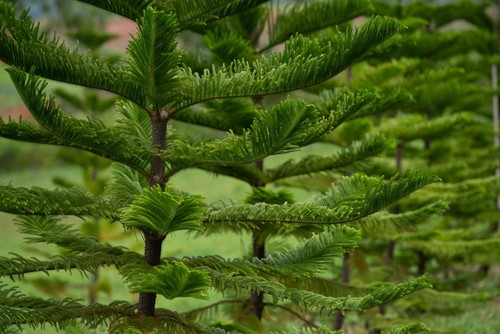Norfolk Island Pine is a popular indoor plant that is known for its unique, symmetrical shape and soft needles. However, if you notice that your Norfolk Island Pine is turning brown, it could be a sign that something is wrong.
Understanding the causes of this issue and how to recognize its symptoms can help you take the necessary steps to prevent further damage and keep your plant healthy.
There are several reasons why a Norfolk Island Pine may turn brown, including overwatering, underwatering, low humidity, and pests. Additionally, the plant may be experiencing environmental stress due to changes in temperature or light conditions.
Recognizing the symptoms of a sick plant, such as brown needles, wilting, or yellowing leaves, can help you identify the problem and take action to address it. With proper care and attention, you can help your Norfolk Island Pine recover and thrive.
Key Takeaways on Norfolk Island Pine Turning Brown
- Norfolk Island Pine may turn brown due to overwatering, underwatering, low humidity, pests, or environmental stress.
- Symptoms of a sick plant include brown needles, wilting, or yellowing leaves.
- Proper care and attention, such as adjusting watering and light conditions, can help prevent and treat brown needles in Norfolk Island Pine.
See these other top picks in this category:
- Night Blooming Cereus Leaves Turning Brown
- Nepenthes Leaves Turning Brown
- My Snake Plant is Turning Brown
Understanding Norfolk Island Pine
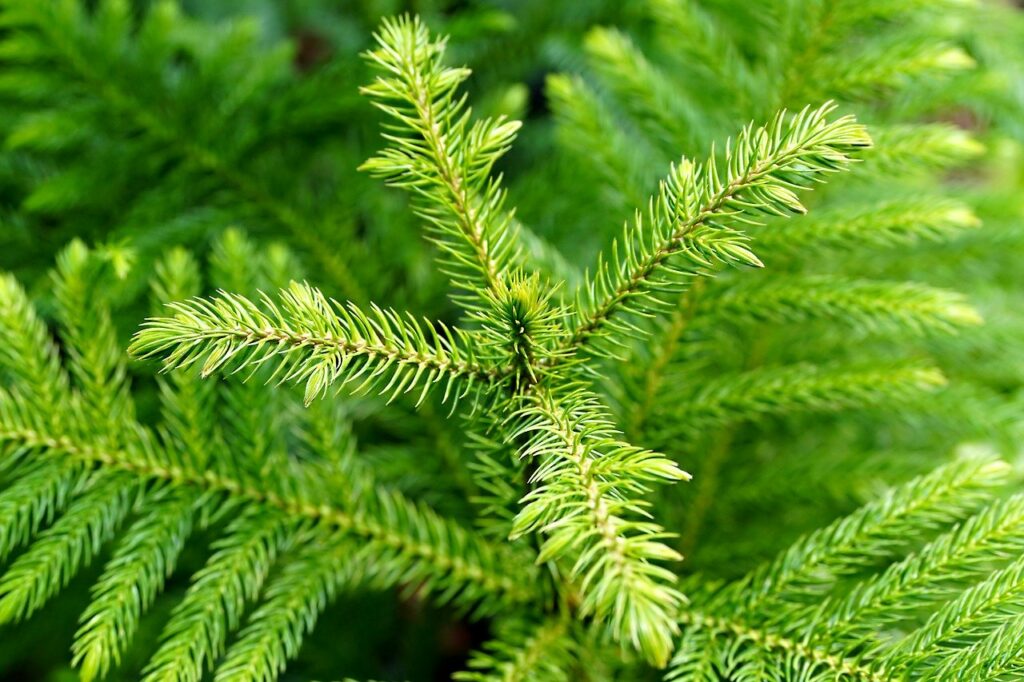
Norfolk Island Pine, also known as Araucaria heterophylla, is a coniferous tree that belongs to the Araucariaceae family. It is a popular houseplant and is often used as a Christmas tree due to its resemblance to traditional Christmas trees. However, it is also grown as a landscape tree in warmer regions.
Norfolk Island Pine trees are native to Norfolk Island, which is located in the South Pacific Ocean. These trees can grow up to 200 feet tall in their natural habitat. However, when grown as houseplants or landscape trees, they usually reach a height of 6 to 8 feet.
One of the unique features of Norfolk Island Pine is that it has a symmetrical, pyramidal shape with tiered branches. The leaves of this tree are needle-like and soft, and they can range in color from light green to dark green.
Norfolk Island Pine is a relatively low-maintenance plant that can thrive in a variety of conditions. However, it is important to note that this tree is sensitive to changes in its environment, and it may start turning brown if it is not cared for properly.
To prevent your Norfolk Island Pine from turning brown, it is important to provide it with the right growing conditions. This includes:
- Light: Norfolk Island Pine requires bright, indirect light. Direct sunlight can scorch the leaves of this tree, while low light can cause the tree to become leggy and weak.
- Water: Norfolk Island Pine prefers moist soil, but it is important not to overwater it. Overwatering can lead to root rot, which can cause the tree to turn brown and die.
- Humidity: Norfolk Island Pine thrives in high humidity. If you live in a dry climate, it may be necessary to mist the tree regularly or use a humidifier to increase the humidity around the tree.
- Temperature: Norfolk Island Pine prefers temperatures between 60 and 70 degrees Fahrenheit. It is important to avoid exposing the tree to extreme temperatures, as this can cause the leaves to turn brown.
By providing your Norfolk Island Pine with the right growing conditions, you can help ensure that it remains healthy and vibrant. However, if you notice that your tree is turning brown, it may be a sign of a larger problem, such as a fungal infection or pest infestation.
In such cases, it is important to take action quickly to prevent the problem from spreading and potentially killing the tree.
Norfolk Island Pine Turning Brown – 6 Common Problems
Norfolk Island Pine is a popular houseplant that can add a touch of greenery to any indoor space. However, if you notice your Norfolk Island Pine turning brown, it is important to take action to address the underlying cause. Here are some common reasons why Norfolk Island Pine may turn brown:
1. Watering Issues
Overwatering or underwatering can both cause Norfolk Island Pine to turn brown. If the soil is too wet, it can lead to root rot, which can cause the entire plant to wilt and turn brown.
On the other hand, if the soil is too dry, the needles and tips of the plant may turn brown and eventually fall off. It is important to water Norfolk Island Pine just enough to keep the soil moist but not waterlogged.
2. Temperature Fluctuations
Norfolk Island Pine is a tropical plant that thrives in warm, humid environments. If the temperature drops below 50°F (10°C), the plant may start to turn brown. Similarly, if the plant is exposed to sudden temperature changes, such as being moved from a warm room to a cold drafty area, it may also turn brown.
3. Soil Conditions

Norfolk Island Pine prefers well-draining soil that is rich in organic matter. If the soil is too heavy or compacted, it may not drain properly, which can lead to root rot and brown needles. It is important to use a high-quality potting mix that is specifically formulated for indoor plants.
4. Humidity Levels
Norfolk Island Pine thrives in humid environments, and low humidity levels can cause the plant to turn brown. If the air in your home is too dry, consider using a humidifier or placing a tray of water near the plant to increase the moisture in the air.
5. Pests and Diseases
Norfolk Island Pine is susceptible to a variety of pests and diseases, including spider mites, mealybugs, and root rot. If you notice brown needles or entire branches falling off, inspect the plant for signs of pests or disease. If you identify a problem, treat it promptly to prevent further damage to the plant.
6. Stress Factors
Norfolk Island Pine may turn brown if it is under stress, such as from being moved to a new location, being repotted, or being exposed to harsh chemicals. To minimize stress, avoid moving the plant around too much and use gentle, natural products to care for the plant.
Recognizing Symptoms
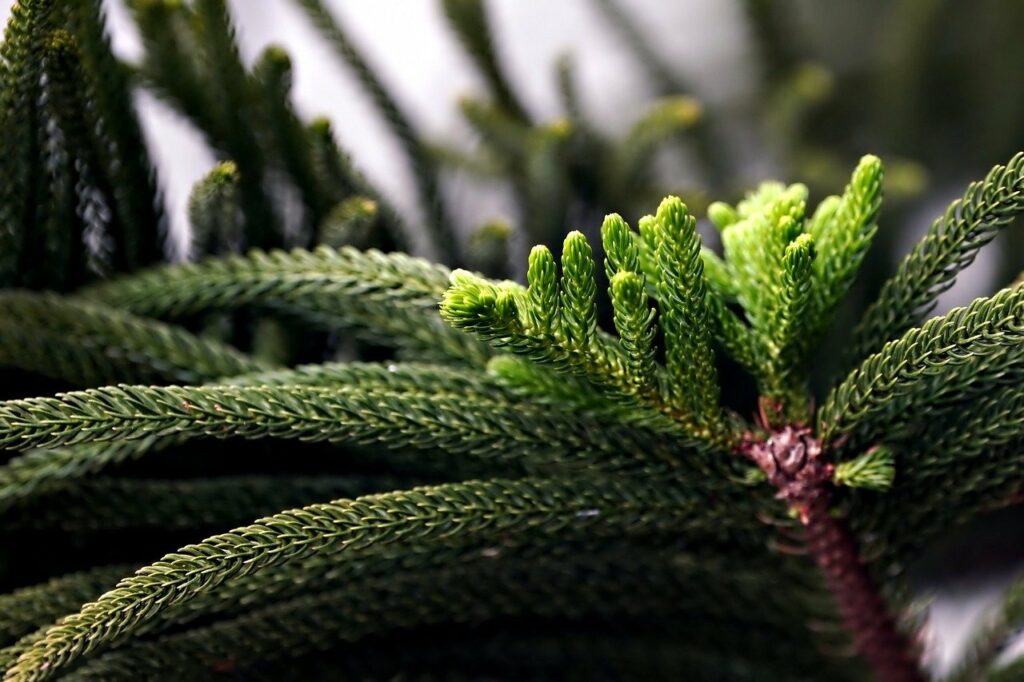
Norfolk Island Pine is a popular indoor plant known for its evergreen foliage. However, it may start turning brown due to various reasons. It is important to recognize the symptoms of a dying Norfolk Island Pine to take appropriate measures to save the plant. Here are some signs to look out for:
Brown Needles and Leaves
If the needles or leaves of the plant start turning brown, it is a sign of distress. Brown needles may indicate a lack of water or too much direct sunlight. On the other hand, brown leaves may indicate fungal or bacterial infection. It is important to identify the cause of the problem and take corrective measures.
Drying Out and Droopy Branches
If the lower branches of the Norfolk Island Pine start drying out, it may be a sign of underwatering. The plant may also develop droopy branches due to overwatering or root rot. It is important to check the soil moisture level and adjust the watering frequency accordingly.
Foliage Damage and Small Spots
Foliage damage may occur due to pests, such as spider mites or mealybugs. These pests may cause small spots on the needles or leaves, which may eventually turn brown. It is important to inspect the plant regularly for signs of pest infestation and take appropriate measures to control them.
Stem and Branches
If the stem or branches of the plant start turning brown, it may indicate a fungal or bacterial infection. These infections may cause the plant to wilt or die. It is important to identify the cause of the problem and take corrective measures, such as pruning infected branches.
Prevention and Treatment
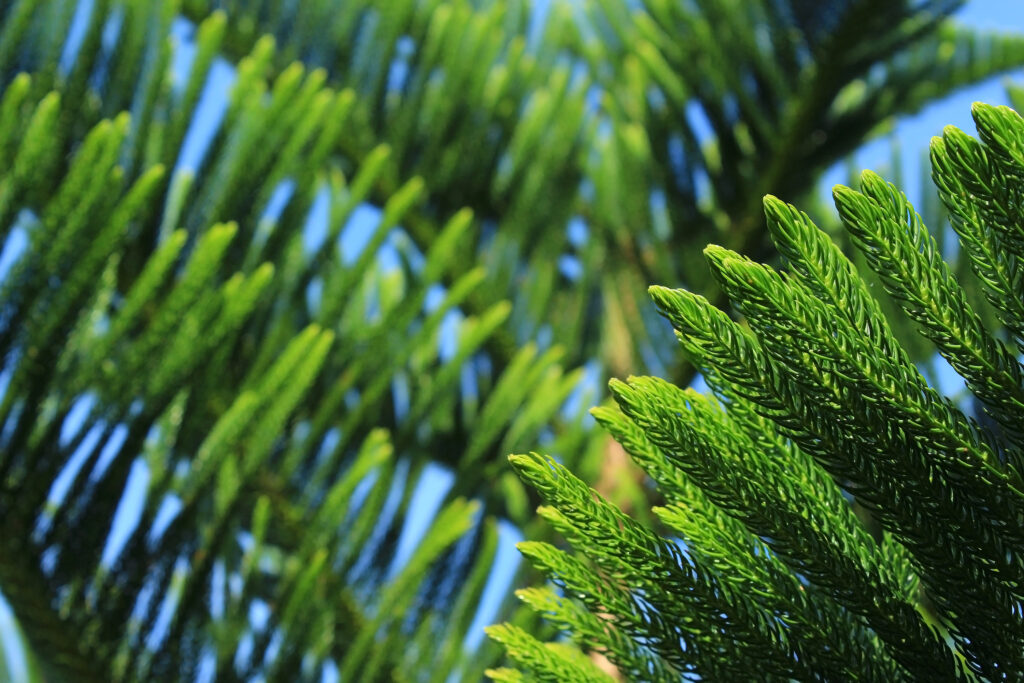
Watering and Soil Management
Proper watering and soil management are crucial to preventing Norfolk Island pine from turning brown. Overwatering can lead to root rot, while underwatering can cause the needles to dry out and turn brown.
It is recommended to water the plant deeply but infrequently, allowing the soil to dry out slightly between waterings. The frequency of watering will depend on factors such as the size of the pot, the temperature, and humidity levels.
Norfolk Island pine prefers fast-draining soil that is slightly acidic to slightly alkaline. Soil that is too salty or too alkaline can cause nutrient deficiencies and lead to needle browning. It is recommended to use a high-quality potting mix that is specifically formulated for indoor plants and to avoid using garden soil.
Temperature and Humidity Control
Norfolk Island pine prefers temperatures between 60 and 70 degrees Fahrenheit during the day and cooler temperatures at night. It is important to avoid exposing the plant to extreme temperatures, such as frost or high heat.
High humidity levels are also important for the health of Norfolk Island pine. The plant prefers humidity levels between 50 and 60 percent. To increase humidity levels, the plant can be misted regularly or placed on a pebble tray filled with water.
Pest and Disease Control
Norfolk Island pine can be susceptible to pests such as mites and needle-browning pests, as well as diseases such as anthracnose and fungal pathogens. It is recommended to regularly inspect the plant for signs of pests or diseases and to take appropriate action if necessary.
To prevent fungal diseases, it is important to avoid overwatering and to ensure proper drainage. If a fungal disease is present, a ready-to-use copper soap fungicide can be applied according to the manufacturer’s instructions. When applying fungicides or pesticides, it is recommended to wear gloves and safety goggles.
Stress Management
Stress can also cause Norfolk Island pine to turn brown. Stress can be caused by factors such as direct sunlight, low humidity levels, and improper watering. To prevent stress, the plant should be placed in a location with indirect light or partial shade and should be watered according to a regular watering schedule.
If a Norfolk Island pine is distressed and turning brown, it is important to identify the cause of the stress and take appropriate action to revive the plant. This may include adjusting the watering schedule, increasing humidity levels, or pruning any damaged or dead branches.
Overall, proper care and maintenance are essential to preventing Norfolk Island pine from turning brown. By following basic culture guidelines and taking appropriate action to address any issues that arise, Norfolk Island pine can thrive in U.S. Department of Agricultural Plant Hardiness Zones 10 and 11.
Additional Care Tips for Norfolk Island Pine
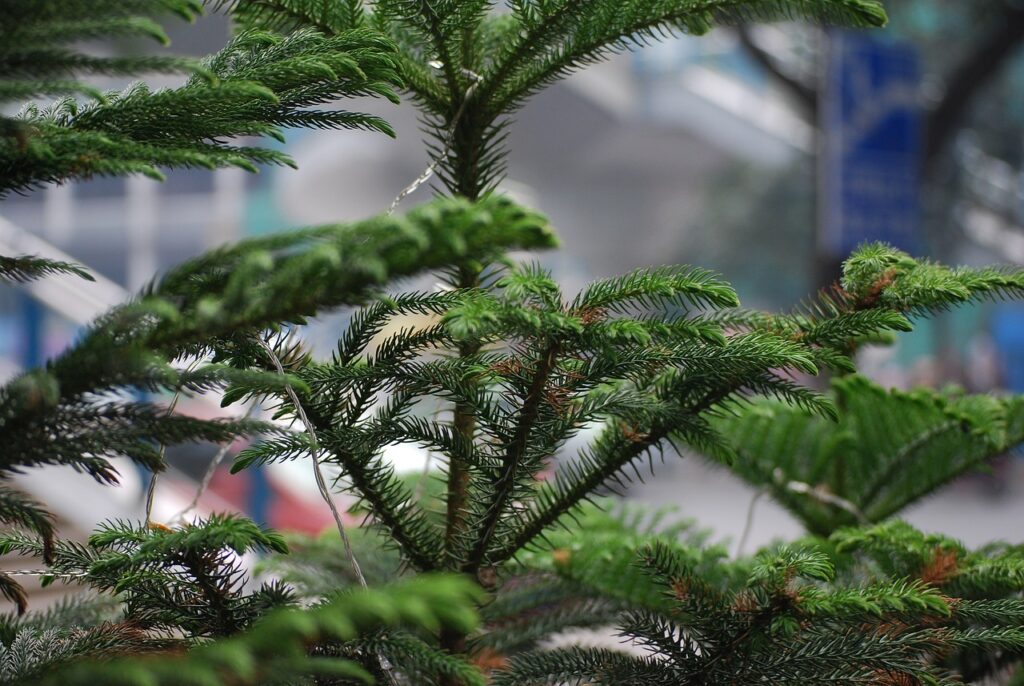
Norfolk Island Pine can turn brown due to various reasons such as overwatering, extreme temperatures, lack of humidity, and pests. Here are some additional care tips to help keep your Norfolk Island Pine healthy:
1. Watering
Overwatering can cause root rot, which can lead to browning of the needles. It is important to water the Norfolk Island Pine only when the top inch of soil is dry. Avoid overhead irrigation as it can cause fungal diseases. Water the plant slowly and deeply, allowing the water to soak into the soil.
2. Humidity
Norfolk Island Pine prefers high humidity levels. Misting the plant or using a humidifier can help increase the humidity levels. Grouping the plant with other houseplants can also create a more humid environment.
3. Fertilizer
Fertilize the plant every two to three months during the growing season with a balanced fertilizer. Do not fertilize during the winter months.
4. Temperature and Light
Norfolk Island Pine prefers temperatures between 60 to 70 degrees Fahrenheit during the day and cooler temperatures at night. It is important to keep the plant in an evenly lit area and rotate it frequently to get equal sunlight on each side. Avoid exposing the plant to extreme temperatures.
5. Pest Control
Norfolk Island Pine can be susceptible to pests such as spider mites and mealybugs. Use insecticidal soap to control these pests. Wear safety goggles and follow the instructions on the label carefully.
6. Disease Control
Norfolk Island Pine can be susceptible to fungal diseases such as Colletotrichum derridis and Colletotrichum needle blight. If the plant is infected, it may need to be relocated to prevent the spread of the disease. The Urban Forest Ecosystems Institute recommends using a fungicide to control these diseases.
Frequently Asked Questions
How to save a dying Norfolk Island Pine?
If a Norfolk Island Pine is turning brown and appears to be dying, there are a few steps that can be taken to try and save it. First, check the soil moisture level and adjust watering accordingly.
Overwatering or underwatering can both cause the tree to turn brown and die. Next, remove any dead or brown branches with scissors or pruning shears. Finally, move the plant to a location with better light conditions and monitor it closely for signs of improvement.
How to fertilize a Norfolk Pine?
Norfolk Island Pines do not require heavy fertilization, but a balanced, water-soluble fertilizer can be applied every 2-3 months during the growing season (spring and summer). Follow the instructions on the fertilizer package carefully and do not over-fertilize, as this can damage the tree.
Norfolk Pine problems?
Norfolk Island Pines can face a variety of problems, including browning of the needles, dropping of branches, and susceptibility to pests and diseases. Overwatering, underwatering, and poor lighting conditions are common causes of problems.
Additionally, pests such as spider mites and scale insects can infest the tree, while diseases such as needle blight and root rot can cause serious damage.
Why is my Norfolk Pine dropping branches?
Norfolk Island Pines may drop branches for a variety of reasons, including overwatering, underwatering, poor lighting conditions, and pest infestations. Additionally, the tree may naturally shed lower branches as it grows taller.
Norfolk Island Pine lifespan indoors?
Norfolk Island Pines can live for many years when grown indoors, with some trees living up to 30 years or more. Proper care, including appropriate watering, lighting, and fertilization, can help to ensure a long lifespan.
Will Norfolk Pine branches grow back?
If a Norfolk Island Pine has dropped branches or had branches removed, new growth may eventually emerge from the remaining branches. However, it is important to note that the tree may not grow back in the exact same shape or form as before.

Hey, I’m Lisa and I’ve been an avid gardener for over 30 years. I love writing, talking and living in the garden! Feel free to connect with me on my socials below

